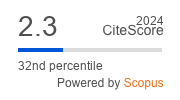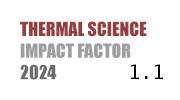THERMAL SCIENCE
International Scientific Journal
IMPACT OF THE R407C AND R134YF REFRIGERANT CHARGE ON THE PERFORMANCE OF A NEW PURE ELECTRIC VEHICLE HEAT PUMP AIR CONDITIONING SYSTEM
ABSTRACT
The objective of this study was to investigate the impact of varying refrigerant charge levels of R407c and R134yf on the refrigeration performance of a vehicle heat pump air conditioning system. The study was conducted under high temperature conditions (45°C) to assess the influence of different refrigerant systems on refrigeration performance parameters. The results demonstrated that the optimal refrigerant charge level can be determined by analyzing the change in refrigeration performance parameters with varying charge levels. The results indicated that an increase in the refrigerant charge of R407c from 2.3 kg to 2.6 kg resulted in a maximum cooling capacity and COP of the system reaching 4.935 kW and 2.1, respectively. The optimal charging capacity of the system was determined to be 2.5 kg. Similarly, an increase in the refrigerant charging capacity of R134yf from 2.3 kg to 3.5 kg resulted in a maximum cooling capacity and COP of the system reaching 5.08 kW and 2.71, respectively. The optimal charging capacity of the system was determined to be 2.9 kg. The COP of the R134yf system is 0.61 higher than that of the R407c system. Furthermore, the energy saving of the R134yf system is more pronounced under extreme conditions.
KEYWORDS
PAPER SUBMITTED: 2023-12-12
PAPER REVISED: 2024-05-16
PAPER ACCEPTED: 2024-05-17
PUBLISHED ONLINE: 2025-07-06
THERMAL SCIENCE YEAR
2025, VOLUME
29, ISSUE
Issue 3, PAGES [1943 - 1950]
- Donateo, T., et al., A Method to Estimate the Environmental Impact of an Electric City Car during Six Months of Testing in an Italian City, Journal of Power Sources, 270 (2014), Dec., pp. 487-498
- Zhuang, X., Jiang K., Research on the Development Roadmap of Pure Electric Vehicles in China, Auto-motive Engineering, 34 (2012), 2, pp. 91-97
- Bing, L., et al., Seasonal Performance Analysis of a Heat Pump with a New R134a Alternative Work Material, Journal of Engineering Thermophysics, 43 (2022), 12, pp. 3177-3183
- Celil, A. M., et al., Performance Evaluation of an Automotive Air Conditioning and Heat Pump System Using R1234yf and R134a, Science and Technology for the Built Environment, 27 (2021), 1. pp. 44-60
- Kwon, C., et al., Performance Evaluation of a Vapor Injection Heat Pump System for Electric Vehicles, International Journal of Refrigeration, 74 (2016), Feb., pp. 138-150
- Zhang, Z., et al., The Solutions to Electric Vehicle Air Conditioning Systems: A Review, Renewable and Sustainable Energy Reviews, 91 (2018), Aug., pp. 443-463
- Ye, W. L., et al., Effect of Mixed Refrigerant Composition on Performance of an Auto-Cascade Refrigeration System Using R600a/R1150/R14, Thermal Science, 28 (2024), 5B, pp. 4307-4320
- Han, S., et al., Influence of Refrigerant Charge on Make-Up Gas Enthalpy Heat Pump System, Journal of Refrigeration, 43 (2022), 6, pp. 114-120
- Hu, X., et al., Experimental Analysis on Refrigerant Charge Optimization for Cold Storage Unit, Procedia Engineering, 205 (2017), Dec., pp. 1108-1114
- Liu, M., et al., Experimental Study on Refrigerant Charge of Heat Pump Air Conditioning System for an Electric Vehicle, Fluid Machinery, 48 (2020), 5, pp. 82-88
- Meng, Y., et al., Comparison and Experiment of Thermodynamic Performance of Refrigerant Blend R134a/R1234yf(R513A) and R134a, Chemical Progress, 38 (2019), 3, pp. 1182-1189
- Wang, Z., et al., An Investigation into the Influences of Refrigerants' Thermal - Physical Properties on Temperature Separation Effect of a Vortex Tube, Thermal Science, 27 (2023), 3B, pp. 2513-2524
- Hongli, W., et al., Energy and Analysis of R1234yf Heat Pump System, Low Temperature and Super-conductivity, 47 (2019), 1, pp. 62-65
- Navarro-Esbrí, J., et al., Experimental Analysis of R1234yf as a Drop-In Replacement for R134a in a Vapor Compression System, International Journal of Refrigeration, 36 (2013), 3, pp. 870-880
- Wei, C. et al., Research Progress and Performance Analysis of HCFC Refrigerant Substitutes, Low Temperature and Superconductivity, 39 (2011), 12, pp. 41-44
- Lee, Y. et al., Performance of Virtually Non-Flammable Azeotropic R1234yf/R134a Mixture for R134a Applications, International Journal of Refrigeration, 36 (2013), 4, pp. 1203-1207
- Jing, Z. et al., Performance Study of R513A Replacing R407C in Locomotive Air conditioning System, Journal of Refrigeration, 44 (2023), 3, pp. 49-57
- Lee, Y., Jung, D., A Brief Performance Comparison of R1234yf and R134a in a Bench Tester for Auto-mobile Applications, Applied Thermal Engineering, 35 (2012), Mar., pp. 240-242
- Li, K., et al. An Experimental and Theoretical Investigation of Refrigerant Charge on a Secondary Loop Air Conditioning Heat Pump System in Electric Vehicles, International Journal of Energy Research, 43 (2019), 8, 3381
- Vaghela, J. K., Comparative Evaluation of an Automobile Airconditioning System Using R134a and Its Alternative Refrigerants, Energy Procedia, 109 (2017), Mar., pp. 153-160

